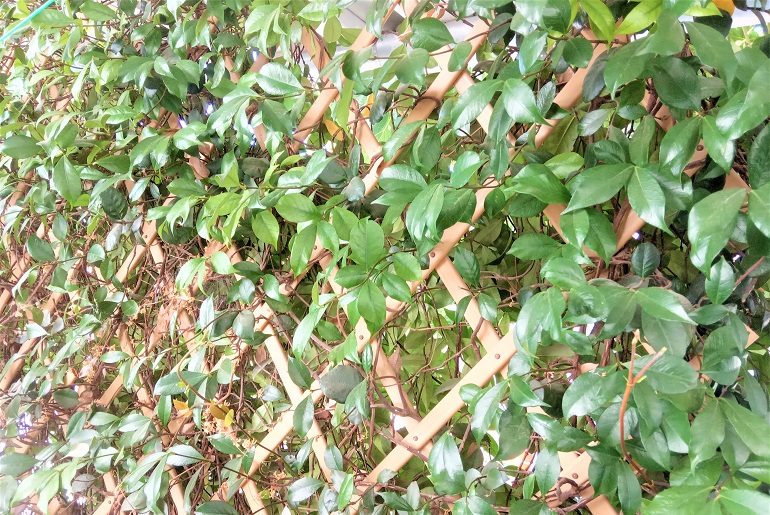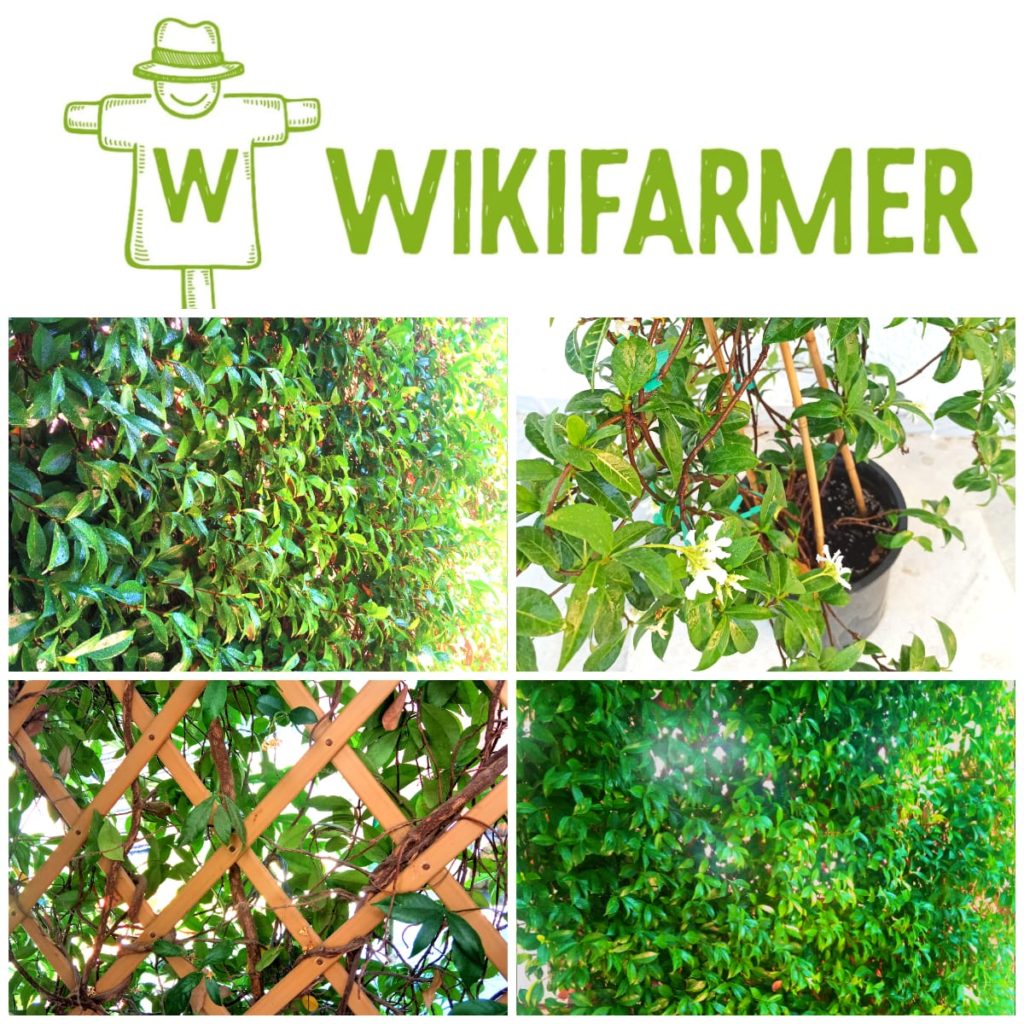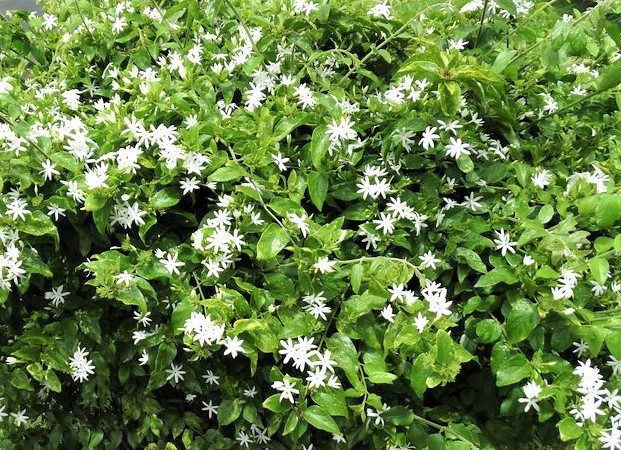Star Jasmine

This post is also available in:
This post is also available in:
![]() Français (French)
Français (French) ![]() Deutsch (German)
Deutsch (German) ![]() Nederlands (Dutch)
Nederlands (Dutch) ![]() हिन्दी (Hindi)
हिन्दी (Hindi) ![]() العربية (Arabic)
العربية (Arabic) ![]() 简体中文 (Chinese (Simplified))
简体中文 (Chinese (Simplified)) ![]() Italiano (Italian)
Italiano (Italian) ![]() 한국어 (Korean)
한국어 (Korean)
Many people wonder which plant would be ideal for climbing on a balcony and creating a nice “fence”. The answer, of course, is none other than the well-known star jasmine (also known as confederate jasmine).
Star jasmine (Trachelospermum jasminoides) is an evergreen perennial shrub widely used to cover pergolas or fences (giving some privacy). Despite its initial slow growth rate, after the first year expands rapidly. It can thrive both in the soil (yard) but also in pots. In temperate and Mediterranean climates, it produces white fragrant flowers, usually from the end of Spring to the start of summers. The oldest star jasmine, which our editorial team has closely examined, is 24 years old, but older ones definitely exist as well. It can climb to great heights and become even 12 meters (39.4 feet) tall. Besides cosmetics, star jasmine has other uses. For example, the essential oil produced by the flowers of this species has antibacterial and anti-inflammatory effects.

Star jasmine has all 4 characteristics necessary for creating a hedge on a balcony. First, it has a strong climbing ability and a rapid growth rate, especially from the second year. As a result, it can produce rich foliage relatively quickly, creating a fence in a short time. Its dense dark green leaves eventually develop a very thick green wall, utterly impenetrable to sight. Additionally, thanks to its evergreen nature, it retains its foliage even during winter and therefore keeps a thick plant fence all year long. That is not the case for most climbing plants used as hedges. Thirdly, it has a long life cycle (several years), even when grown into pots, making it ideal for apartments and spaces where it is impossible to plant it in the soil. Finally, despite that star jasmine is originated from Asia (some related species come from the Himalayas), it has adapted perfectly to the environmental conditions of temperate climates. The plant is highly resistant to heat but can also survive in low temperatures (up to -10 degrees Celsius, 14 Fahrenheit).
All the basic principles for creating a fence of star jasmine (growing in pots).
Buy the plant and decide where to place the pot.
After we have bought the star jasmine from the plant nursery, we need to transplant it.
At this point, we need to select a proper spot for placing the plant to grow. Despite its ability to grow in semi-shady places, 1.5 hours of direct access to sunlight can accelerate the foliage formation. Protection of the plant from the strong winds is also necessary. In this case, the fence formed will be denser. Additionally, the plant needs to be protected from strong winds.
Transplantation
After buying our star jasmine, we first need to transplant it into a larger pot made of plastic or terracotta. Regardless of its material, we need to open holes at the bottom of the pot allowing drainage of the extra water within minutes. We start with a relatively small pot (larger than the plastic one star was growing in the nursery). For example, the flowerpot we bought from the nursery was 9 liters, and we transplanted it into a 20-liter flowerpot. By choosing a mix of potting soil and river sand can facilitate drainage. We can also add some compost.
 Giving initial Direction in of Star Jasmine’s Growth
Giving initial Direction in of Star Jasmine’s Growth
To support an initial vertical plant growth and help it climb into the arbor, we might need to guide and tight the central shoot manually. After that, the plant won’t need any assistance, as it will start to grow upwards without any problems.
When and how to prune our Star Jasmine plants
Every spring and autumn, we must cut off the dry leaves and branches and remove any dead plant material. However, the main pruning of star jasmine takes place from the end of the flowering stage until the beginning of autumn. Most people prefer to prune their plant only to give shape and control the excessive vegetative growth in the “wrong” direction. This way, we encourage the plants to devote their resources to producing more shoots and leaves where we want them. Also, in the third and fourth year of the plant’s life, pruning is needed to increase airflow in the interior of its canopy. If we don’t remove parts of the old vegetation, the new will pile up, creating conditions of insufficient ventilation for the plant. The pruning shears we will use during the deadheading must be of high quality and accompanied by the corresponding certificates.
Personal Safety during Pruning
The plant secretes a white sticky substance from the cut plant tissues, which may irritate the skin. To protect our hands during gardening, we could consider buying special gloves.
Star Jasmine’s Water Requirements – Irrigation Of Star Jasmine
Star jasmine might be drought-tolerant, but it is definitely less tolerant in pots than in the soil. Especially during summer, it needs watering 2-3 times a week. In winter, the plant requires much fewer quantities added. It is pretty common to add compost in the pots to help the soil retain moisture and reduce water evaporation.
 Fertilization of Star Jasmine
Fertilization of Star Jasmine
Several star jasmine lovers claim that they have not added anything to their pot other than compost, and indeed their plants are pretty impressive in growth and flowering. However, especially in the first two years, adding a fertilizer (e.g., N-P-K 7-7-7) once a month from spring to late summer is recommended. The fertilizer can be water-soluble or in granular form. In the latter case, we need to water immediately after the application.








































































